|
|
Luigi Dallapiccola (Composer) |
|
Born: February 3, 1904 - Pisino d'Istria, Itayly (current Pazin, Croatia)
Died: February 19, 1975 - Florence, Italy |
|
Luigi Dallapiccola was an Italian composer known for his lyrical twelve-tone compositions. |
|
Biography |
|
Luigi Dallapiccola was born to Italian parents. Unlike many composers born into highly musical environments, his early musical career was irregular at best. Political disputes over his birthplace of Istria, then part of the Austrian empire, led to instability and frequent moves. His father was headmaster of an Italian-language school - the only one in the city - which was shut down at the start of World War I. The family, considered politically subversive, was placed in internment at Graz, Austria, where the budding composer hadn't even access to a piano, though he did attend performances at the local opera house, which cemented his desire to pursue composition as a career. Once back to his hometown Pisino after the war, he travelled frequently.
Luigi Dallapiccola took his piano degree at the Florence Conservatory in the 1920s and became professor there in 1931; until his 1967 retirement he spent his career there teaching lessons in piano as a secondary instrument, replacing his teacher Ernesto Consolo as the older man's illness prevented him from continuing. He also studied composition with Vito Frazzi at the Conservatorio Luigi Cherubini. Dallapiccola's students include Abraham Zalman Walker, Luciano Berio, Bernard Rands, Donald Martino, Halim El-Dabh, Ernesto Rubin de Cervin, Arlene Zallman, Noel Da Costa, and Raymond Wilding-White.
Luigi Dallapiccola's early experiences under the fascist regime of Benito Mussolini colored his outlook and output for the rest of his life. He once supported Mussolini, believing the propaganda, and it was not until the 1930s that he became passionate about his political views, in protest to the Abyssinian campaign and Italy's involvement in the Spanish Civil War. Mussolini's sympathy with Adolf Hitler's views on race, which threatened Dallapiccola's Jewish wife Laura Luzzatto, only hardened his stance. Canti di prigionia and Il prigioniero are reflections of this impassioned concern; the former was his first true protest work. During World War II he was in the dangerous position of opposing the Nazis; though he tried to go about his career as usual, and did, to a limited extent. On two occasions he was forced to go into hiding for several months. Dallapiccola continued his touring as a recitalist - but only in countries not occupied by the Nazis.
Though it was only after the war that his compositions made it into the public eye (with his opera Il prigioniero sparking his fame), it was then that his life became relatively quiet. He made frequent travels to the USA, including appearances at Tanglewood in the summers of 1951 and 1952 and several semesters of teaching courses in composition at Queens College, New York beginning in 1956. He was a sought-after lecturer throughout Western Europe and the Americas. Dallapiccola's 1968 opera Ulisse would be the peak of his career, after which his compositional output was sparse; his later years were largely spent writing essays rather than music.
Luigi Dallapiccola had no more finished compositions after 1972 due to his failing health, and he died in Florence in 1975 of edema of the lungs. There are, however, a very few sketches and fragments of work from this period, including a vocal work left unfinished just hours before his death. |
|
Music |
|
It was Richard Wagner's music that inspired Luigi Dallapiccola to start composing in earnest, and Claude Debussy's that caused him to stop: hearing Der fliegende Holländer while exiled to Austria convinced the young man that composition was his calling, but after first hearing Debussy in 1921 he stopped composing for three years in order to give this important influence time to sink in. The neoclassical works of Ferruccio Busoni would figure prominently in his later work, but his biggest influence would be the ideas of the Second Viennese School, which he encountered in the 1930s, particularly Alban Berg and Anton Webern. Dallapiccola's works of the 1920’s have been withdrawn, with the instruction that they never be performed, though they still exist under controlled access for study.
His works widely use the serialism developed and embraced by his idols; he was, in fact, the first Italian to write in the method, and the primary proponent of it in Italy, and he developed serialist techniques to allow for a more lyrical, tonal style. Throughout the 1930’s his style developed from a diatonic style with bursts of chromaticism to a consciously serialist outlook. He went from using twelve-tone rows for melodic material to structuring his works entirely serially. With the adoption of serialism he never lost the feel for melodic line that many of the detractors of the Second Viennese School claimed to be absent in modern dodecaphonic music. His disillusionment with Mussolini's regime effected a change in his style: after the Abyssinian campaign he claimed that his writing would no longer ever be light and carefree as it once was. While there are later exceptions, particularly the Piccolo concerto per Muriel Couvreux, this is largely the case.
Liriche Greche (1942-1945), for solo voice with instruments, would be his first work composed entirely in this twelve-tone style, composed concurrently with his last original purely diatonic work, the ballet Marsia (1943). The following decade showed a refinement in his technique and the increasing influence of Anton Webern's work. After this, from the 1950’s on, the refined, contemplative style he developed would characterize his output, in contrast to the more raw and passionate works of his youth. Most of his works would be songs for solo voice and instrumental accompaniment. His touch with instrumentation is noted for its impressionistic sensuality and soft textures, heavy on sustained notes by woodwinds and strings (particularly middle-range instruments, such as the clarinet and viola).
The politically charged Canti di prigionia for chorus and ensemble was the beginning of a loose triptych on the highly personal themes of imprisonment and injustice; the one-act opera Il prigioniero and the cantata Canti di liberazione completed the trilogy. Of these, Il prigioniero (1944-1948) has become Dallapiccola's best-known work. It tells the chilling story of a political prisoner whose jailor, in an apparent gesture of fraternity, allows him to escape from his cell. At the moment of his freedom, however, he finds he has been the victim of a cruel practical joke as he runs straight into the arms of the Grand Inquisitor, who smilingly leads him off to the stake at which he is to be burned alive. The opera's pessimistic outlook reflects Dallapiccola's complete disillusionment with fascism (which he had naïvely supported when Mussolini first came to power) and the music contained therein is both beautifully realized and supremely disquieting.
His final opera Ulisse, with his own libretto after The Odyssey, was the culmination of his life's work. It was composed over 8 years, including and developing themes from his earlier works, and was his last large-scale composition. |
|
Selected Works |
|
Partita , for orchestra (1930-1932)
Musica per tre pianoforti, for 3 pianos (1935)
Tre laudi, for voice & 13 instruments (1936-1937)
Volo di Notte, one-act opera (1938)
Canti di prigionia, for chorus, two pianos, 2 harps & percussion (1938-1941)
Piccolo concerto per Muriel Couvreux, for piano & chamber orchestra (1939-1941)
Liriche Greche (1942-1945)
Marsia, ballet (1943)
Il prigioniero, opera (1944-1948)
Ciaccona, Intermezzo e Adagio, for solo cello (1945)
Sonatina canonica su Capricci di Niccolo Paganini per pianoforte, for piano (1946)
Quattro liriche di Antonio Machado, for soprano & piano (1948)
Job, opera (1950)
Tartiniana, for violin & orchestra (1951)
Canti di liberazione, for mixed chorus & orchest (1951-1955)
Quaderno musicale di Annalibera, for solo piano, featuring the BACH motif (1952)
Goethe-Lieder, for mezzo soprano, piccolo clarinet, clarinet, and bass clarinet (1953)
An Mathilde, for soprano & orchestra (1955)
Tartiniana seconda, for violin & orchestra (1955-1956)
Cinque canti, for baritone & 8 instruments (1956)
Requiescant, for chorus & orchestra (1957-1958)
Three Questions With Two Answers, for orchestra (1962)
Preghiere, for baritone & chamber orchestra (1962)
Ulisse, opera (1960-1968)
Sicut umbra, for mezzo-soprano & 12 instruments (1970)
Commiato, for soprano & ensemble (1972)
Writings by Dallapiccola:
Dallapiccola on Opera, Selected writings of Luigi Dallapiccola, Vol 1 (Toccata Press, 1987)
Dallapiccola on Music and Musicians, Selected writings of Luigi Dallapiccola, Vol. 2 (Toccata Press) |
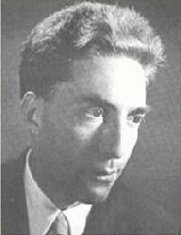
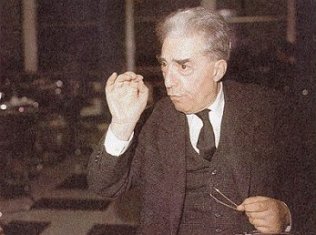
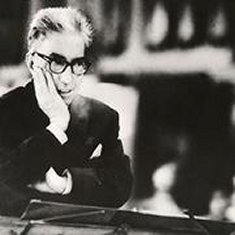
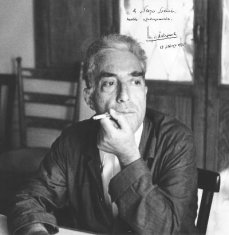
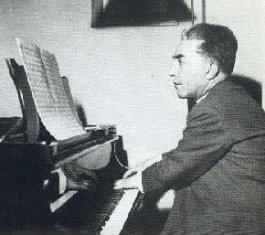

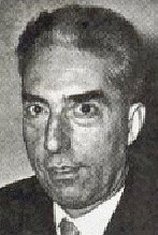
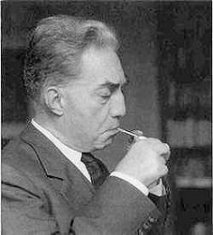

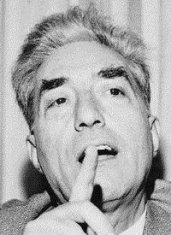 |
|
Source: Wikipedia Website (April 2011; based on John C. G. Waterhouse, "Luigi Dallapiccola". Grove Music Online & Anthony Sellors, "Luigi Dallapiccola", "Ulisse", "Il prigionero". Grove Music Online (OperaBase).
Contributed by Aryeh Oron (July 2011) |
|
Luigi Dallapiccola : Short Biography | Bach-inspired Piano Works: Works | Recordings | Other Arrangements/Transcriptions: Works | Recordings |
|
Links to other Sites |
|
Luigi Dallapoiccola (Wikipedia)
Luigi Dallapiccola Overview (Composition: Today
Luigi Dallapiccola (Prominent Istrians) |
Luigi Dallapiccola - Biography (IRCAM) [French]
Luigi Dallapiccola - Biography (AMG)
Luigi Dallapiccola - Bio (Naxos) |
|
Bibliography |
|
Raymond Fearn : The music of Luigi Dallapiccola (New York, Rochester, 2003)
Edward Wilkinson: "An interpretation of serialism in the work of Luigi Dallapiccola" (Phd diss., Royal Holloway, 1982)
Ben Earle: "Musical modernism in fascist Italy: Dallapiccola in the thirties" (Phd diss., Cambridge, 2001) |
|
|